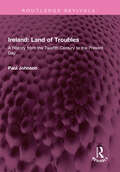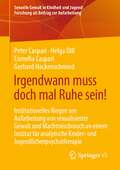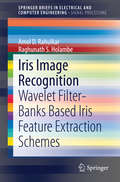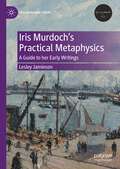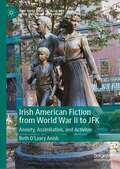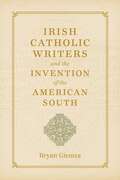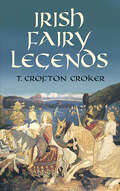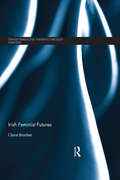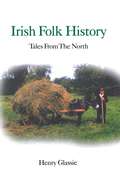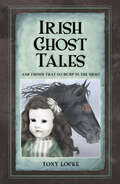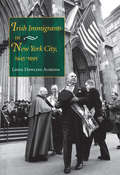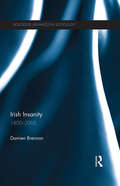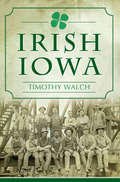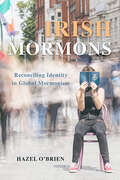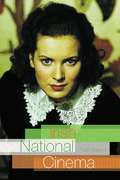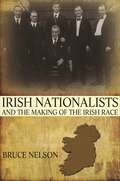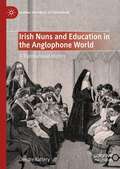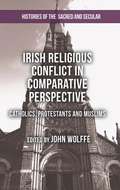- Table View
- List View
Ireland: A History from the Twelfth Century to the Present Day (Routledge Revivals)
by Paul JohnsonFirst published in 1980, Ireland: Land of Troubles is a fascinating and eminently readable account of Ireland’s history from the twelfth century which gives a valuable insight into her twentieth century Troubles. Ireland is a country which has produced examples of the finest flowering of Western culture but also witnessed centuries of turbulence and bloodshed. From the first establishment of an English presence around Dublin in the twelfth century, Ireland’s turbulence has been responsible for wrecking the reputations and destroying the causes of Richard II, the Earl of Essex, Charles I and James II and a host of Lords Lieutenant and Ministers, but no one could get to the heart of the ‘Irish problem.’ And the great famine and depopulation of Ireland in the nineteenth century, when four million of her people emigrated – many to America – gave a boost to Irish nationalism and the struggle for Home Rule, culminating eventually in Partition and the continuing Troubles. The author combines his account of Ireland’s history with a penetrating insight into the rise of the Anglo-Irish Establishment and the cultural and religious divides which form an integral part of his story. This book will be of interest to students of history, political science, war studies, ethno-nationalism and internal security.
Ireland’s Great Famine and Popular Politics (Routledge Studies in Modern European History)
by Enda Delaney Breandán Mac SuibhneIreland's Great Famine of 1845-52 was among the most devastating food crises in modern history. A country of some eight-and-a-half-million people lost one million to hunger and disease and another million to emigration. According to land activist Michael Davitt, the starving made little or no effort to assert "the animal's right to existence," passively accepting their fate. But the poor did resist. In word and deed, they defied landlords, merchants and agents of the state: they rioted for food, opposed rent and rate collection, challenged the decisions of those controlling relief works, and scorned clergymen who attributed their suffering to the Almighty. The essays collected here examine the full range of resistance in the Great Famine, and illuminate how the crisis itself transformed popular politics. Contributors include distinguished scholars of modern Ireland and emerging historians and critics. This book is essential reading for students of modern Ireland, and the global history of collective action.
Irgendwann muss doch mal Ruhe sein!: Institutionelles Ringen um Aufarbeitung von sexualisierter Gewalt und Machtmissbrauch an einem Institut für analytische Kinder- und Jugendlichenpsychotherapie (Sexuelle Gewalt in Kindheit und Jugend: Forschung als Beitrag zur Aufarbeitung)
by Gerhard Hackenschmied Peter Caspari Helga Dill Cornelia CaspariDas Buch liefert – erstmals im deutschsprachigen Raum – einen umfassenden wissenschaftlichen Beitrag zur Aufarbeitung sexualisierter Gewalt in einem Psychotherapieinstitut. Die qualitative Fallstudie nimmt jahrzehntelangen Machtmissbrauch und sexualisierte Gewalt durch den Leiter eines analytischen Kinder- und Jugendinstituts in den Blick. Dabei zeigt sich, dass die in diesem System verstrickten Psychotherapeut*innen zentralen Vorstellungen und Konzepten ihrer Profession nicht gerecht werden: Schweigen, Verleugnung, Rationalisierung, Abwehr von Verantwortung und Ignoranz gegenüber Betroffenen verhindern über lange Zeit die Aufdeckung der Taten und nachhaltige Formen der Aufarbeitung. Das Institutsleben wird von einer dialektischen Spannung zwischen der Notwendigkeit der Bearbeitung und dem Wunsch nach ungestörtem Funktionieren geprägt. Diese Dynamik erweist sich zugleich als Analogie zu Problembewältigungsmustern psychotherapeutischer Patient*innen. Der Fall verweist auf grundsätzliche Probleme im Bereich der Psychotherapie, die vor allem mit einem strukturellen Machtungleichgewicht und ausgeprägten Abhängigkeitsverhältnissen sowohl im Kontext der Ausbildung als auch im Behandlungssetting zu tun haben. Aus den Erkenntnissen dieser empirischen Untersuchung werden professions- und organisationsethische Überlegungen abgeleitet und – darauf basierend – konkrete Empfehlungen zur Prävention von sexualisierter Gewalt in Psychotherapieinstituten formuliert.
Iris Image Recognition
by Raghunath S. Holambe Amol D. RahulkarThis book provides the new results in wavelet filter banks based feature extraction, and the classifier in the field of iris image recognition. It provides the broad treatment on the design of separable, non-separable wavelets filter banks, and the classifier. The design techniques presented in the book are applied on iris image analysis for person authentication. This book also brings together the three strands of research (wavelets, iris image analysis and classifier). It compares the performance of the presented techniques with state-of-the-art available schemes. This book contains the compilation of basic material on the design of wavelets that avoids reading many different books. Therefore, it provides an easier path for the new-comers, researchers to master the contents. In addition, the designed filter banks and classifier can also be effectively used than existing filter-banks in many signal processing applications like pattern classification, data-compression, watermarking, denoising etc. that will give the new directions of the research in the relevant field for the readers.
Iris Murdoch’s Practical Metaphysics: A Guide to her Early Writings (Iris Murdoch Today)
by Lesley JamiesonThis book explores Iris Murdoch as a philosopher who, through her distinctive methodology, exploits the advantages of having a mind on the borders of literature and politics in her early career writings (pre-The Sovereignty of Good). By focusing on a single decade of Murdoch’s early career, Jamieson tracks connections between her views on the state of literature and politics in postwar Britain and her approach to the philosophy of mind and moral philosophy. Furthermore, this close study reveals that, far from a stylistic quirk, Murdoch’s use of metaphors, analogies, and other literary devices is internal to her methodology. Finally, rather than asking what Murdoch’s views are, this work will ask “what is Murdoch trying to achieve with her writings and public lectures, and how does she go about this?” By answering the latter question, we will have a new strategy for interpreting her writings more generally. The book contributes to the growing body of scholarship focusing on Iris Murdoch’s philosophical writings, and on women in the history of analytic philosophy.
Irish American Fiction from World War II to JFK: Anxiety, Assimilation, and Activism (New Directions in Irish and Irish American Literature)
by Beth O’Leary AnishIrish American Fiction from World War II to JFK addresses the concerns of Irish America in the post-war era by studying its fiction and the authors who brought the communities of their youth to life on the page. With few exceptions, the novels studied here are lesser-known works, with little written about them to date. Mining these tremendous resources for the details of Irish American life, this book looks back to the beginning of the twentieth century, when the authors' immigrant grandparents were central to their communities. It also points forward to the twenty-first century, as the concerns these authors had for the future of Irish America have become a legacy we must grapple with in the present.
Irish Canadian Conflict and the Struggle for Irish Independence, 1912-1925
by Robert MclaughlinBetween 1912 and 1925, Ireland convulsed with political and revolutionary upheaval in pursuit of self-government. Canadians of Irish descent, both Catholic and Protestant, diligently followed these conflicts, and many became actively involved in the dramatic events overseas. Irish Canadian Conflict and the Struggle for Irish Independence tells the unique story of how Irish Canadians identified with their ancestral homeland during this revolutionary era. Drawing on ethnic weekly newspapers and fraternal society records, Robert McLaughlin finds new interpretations of how Orange Canadian unionists and Irish Canadian nationalists viewed their heritage, their membership in the British Empire, and even Canadian citizenship itself.McLaughlin also provides strong evidence that neither time nor distance diminished Irish Canadians' attachment to their familial homeland or their identification with their respective ethnic communities in Ireland. Irish Canadian Conflict and the Struggle for Irish Independence reconsiders existing contextual frameworks and confronts the challenging questions inherent in understanding this period.
Irish Catholic Writers and the Invention of the American South: Domestic Workers and Their Employers in the Segregated South (Southern Literary Studies)
by Bryan GiemzaIn this comprehensive study, Bryan Giemza retrieves a missing chapter of Irish Catholic heritage by canvassing the literature of American Irish writers from the U.S. South.Beginning with the first Irish American novel, published in Winchester, Virginia, in 1817, Giemza investigates nineteenth-century writers contending with the turbulence of their time -- writers influenced by both American and Irish revolutions, dramatists and propagandists of the Civil War, and memoirists of the Lost Cause. Some familiar names arise in an Irish context, including Joel Chandler Harris and Kate (O'Flaherty) Chopin. Giemza then turns to the works of twentieth-century writers, such as Margaret Mitchell, John Kennedy Toole, and Pat Conroy. For each author, Giemza traces the impact of Catholicism on their ethnic identity and their work. Giemza draws on many never-before-seen documents, including the correspondence of Cormac McCarthy, interviews with members of the Irish community in Flannery O'Connor's native Savannah, Georgia, and Giemza's own correspondence with writers such as Valerie Sayers and Anne Rice. This lively history prompts a new understanding of how the Catholic Irish in the South helped invent a regional myth, an enduring literature, and a national image.
Irish Essays
by Denis DonoghueDenis Donoghue has been a key figure in Irish studies and an important public intellectual in Ireland, the UK and US throughout his career. These essays represent the best of his writing and operate in conversation with one another. He probes the questions of Irish national and cultural identity that underlie the finest achievements of Irish writing in all genres. Together, the essays form an unusually lively and far-reaching study of three crucial Irish writers - Swift, Yeats and Joyce - together with other voices including Mangan, Beckett, Trevor, McGahern and Doyle. Donoghue's forceful arguments, deep engagement with the critical tradition, buoyant prose and extensive learning are all exemplified in this collection. This book is essential reading for all those interested in Irish literature and culture and its far-reaching effects on the world.
Irish Fairy Legends (Celtic, Irish Ser.)
by T. Crofton CrokerCome sit by the fire — a world of enchantment awaits you in this treasury of classic Irish stories by folklorist T. Crofton Croker. From 1812 to 1816, he roamed southern Ireland, listening to his countrymen's stories of pixies, leprechauns, and other supernatural creatures. The result is one of the first collections of Irish fairy tales on record — and it's often considered the finest. Told in plain but colorful language with charming illustrations that capture the wonder of these tales, it became an overnight bestseller. An engaging mix of darkness and humor, the thirty-eight stories are filled to the brim with Irish wit and magic. In "The Haunted Cellar," you'll meet one of Ireland's oldest families, with blood as thick as buttermilk and a reputation for hospitality. But what is the secret in Justin Mac Carthy’s wine cellar that forces every butler to quit? In "The Changeling," a new mother finds a just solution when her infant is replaced by a mischievous fairy. "The Legend of Knockfierna" teaches fearless Carroll O'Daly a hard lesson about interfering with the "little people." And that's just a taste of the delights inside. A rich reflection of Celtic culture, Irish Fairy Legends will entertain you and your family for generations.
Irish Feminist Futures (Transformations)
by Claire BrackenThis book is about the future: Ireland’s future and feminism’s future, approached from a moment that has recently passed. The Celtic Tiger (circa 1995-2008) was a time of extraordinary and radical change, in which Ireland’s economic, demographic, and social structures underwent significant alteration. Conceptions of the future are powerfully prevalent in women’s cultural production in the Tiger era, where it surfaces as a form of temporality that is open to surprise, change, and the unknown. Examining a range of literary and filmic texts, Irish Feminist Futures analyzes how futurity structures representations of the feminine self in women’s cultural practice. Relationally connected and affectively open, these representations of self enable sustained engagements with questions of gender, race, sexuality, and class as they pertain to the material, social, and cultural realities of Celtic Tiger Ireland. This book will appeal to students and scholars of Irish studies, Irish feminist criticism, sociology, cultural studies, literature, women's studies, gender studies, neo-materialist and feminist theories.
Irish Folk History: Tales from the North
by Henry GlassieMade of the words of the people who live today in the beautiful, embattled countryside of Ulster, Irish Folk History is, in essence, the people's own statement of their past. In story, song, and spontaneous essay, these texts, selected from Passing the Time in Ballymenone, tell of the coming of Christianity, of endless war, of the hardships and delights of rural life.During a time of trouble, Henry Glassie came into a community of active story-tellers in County Fermanagh in Northern Ireland, and in this book he sets their voices—their chuckles, whispers, and anger—before us. The words of Hugh Nolan, Michael Boyle, of Peter Flanagan, Hugh Patrick Owens, and their neighbors, echo from the page to present a tale that is at once the story of their tiny community and the story of all of Ireland.
Irish Ghost Tales: And Things that go Bump in the Night
by Tony LockeDo ghosts exist, do supernatural beings walk the land and do creatures linger in the shadows. Are legends of blood-sucking creatures based on some truth found on the edges of reality? Within these pages Tony Locke will take you on a journey through the magical land of Erin. You will explore castles and graveyards, and be introduced to banshees, warlocks, spectres, poltergeists and the Undead. You will read about the spirit of a child that possesses a doll, the vengeful druid who guards a tomb and the ghost of a cannibal woman who enjoyed eating children. Based on the myths and legends of Ireland, these tales have been collected and retold by professional storyteller Tony Locke. So why not pull up a chair and sit awhile? You know you’re never too old for a story.
Irish Immigrants in New York City, 1945-1995
by Linda Dowling AlmeidaIrish Immigrants in New York City, 1945-1995Linda Dowling AlmeidaThe story of one of the most visible groups of immigrants in the major city of immigrants in the last half of the 20th century."Almeida offers a dynamic portrait of Irish New York, one that keeps reinventing itself under new circumstances." —Hasia Diner, New York University"[Almeida’s] close attention to changes in economics, culture, and politics on both sides of the Atlantic makes [this book] one of the more accomplished applications of the ‘new social history’ to a contemporary American ethnic group." —Roger Daniels, University of CincinnatiIt is estimated that one in three New York City residents is an immigrant. No other American city has a population composed of so many different nationalities. Of these "foreign born," a relatively small percentage come directly from Ireland, but the Irish presence in the city—and America—is ubiquitous. In the 1990 census, Irish ancestry was claimed by over half a million New Yorkers and by 44 million nationwide. The Irish presence in popular American culture has also been highly visible.Yet for all the attention given to Irish Americans, surprisingly little has been said about post–World War II immigrants. Almeida’s research takes important steps toward understanding modern Irish immigration. Comparing 1950s Irish immigrants with the "New Irish" of the 1980s, Almeida provides insights into the evolution of the Irish American identity and addresses the role of the United States and Ireland in shaping it.She finds, among other things, that social and economic progress in Ireland has heightened expectations for Irish immigrants. But at the same time they face greater challenges in gaining legal residence, a situation that has led the New Irish to reject many organizations that long supported previous generations of Irish immigrants in favor of new ones better-suited to their needs.Linda Dowling Almeida, Adjunct Professor of History at New York University, has published articles on the "New Irish" in America and is a longtime member of the New York Irish History Roundtable. She also edited Volume 8 of the journal New York Irish History.March 2001232 pages, 6 1/8 x 9 1/4, index, append.cloth 0-253-33843-3 $35.00 s / £26.5
Irish Insanity: 1800–2000 (Routledge Advances in Sociology)
by Damien BrennanThe national public asylum system in Ireland was established during the early nineteenth century and continued to operate up to the close of the twentieth century. These asylums / mental hospitals were a significant physical and social feature of Irish communities. They were used intensively and provided a convenient form of institutional intervention to manage a host of social problems. Irish Insanity identifies the long-term trends in institutional residency through the development of a detailed empirical data set, based on an analysis of original copies of the reports of Inspector of Asylums/Mental Hospitals in Ireland. Damien Brennan explores core social and historical features linked to this data including: the political context governance and social policy the relationship between church and state changing economic structures and social deprivation professionalization legislation and systems of admission and discharge categorisation and diagnostic criteria international developments family dynamics This book demonstrates that the actual rate of asylum utilisation in Ireland was the highest by international standards, but challenges the idea that an "epidemic of Irish insanity" actually existed. Offering a historical and sociological insight into an institutional legacy that is unusual within the international context, this book will be of particular relevance and interest to scholars within the fields of sociology, criminology, law, history, Irish studies, social policy, anthropology, nursing and medicine.
Irish Iowa (American Heritage)
by Timothy WalchIowa offered freedom and prosperity to the Irish fleeing famine and poverty. They became the second-largest immigrant group to come to the state, and they acquired influence well beyond their numbers. The first hospitals, schools and asylums in the area were established by Irish nuns. Irish laborers laid the tracks and ran the trains that transported crops to market. Kate Shelley became a national heroine when she saved a passenger train from plunging off a bridge. The Sullivan family became the symbol of sacrifice when they lost their five sons in World War II. Author Timothy Walch details these stories and more on the history and influence of the Irish in the Heartland.
Irish Lore and Legends
by S. M. W. DunnitThese tales written for adults transport the reader to the farthest reaches of Irish memory with wisdom, wit, history, heroics, folly, conflict, quest, loyalty and the success of both rich and poor. You will read of the deeds of some of Ireland's most beloved, long enduring heroes of pre-history and myth including Finn M'Coul the revered giant of great deeds who when faced with a giant of equal power, turns to his wife for rescue and the Warrior maiden Meav who provokes a bloody battle because a cattleman won't sell her his prize bull. You will also find the Irish fairies, charms and castles, the blend of Celtic and Christian belief is ever present, and the lilting Irish way with words will draw you in to the realms of magical Irish lore.
Irish Mormons: Reconciling Identity in Global Mormonism
by Hazel O'BrienThe Church of Jesus Christ of Latter-day Saints is one of the international religions that have arrived from abroad to find adherents in Ireland. Drawing on fieldwork in two LDS communities, Hazel O’Brien explores how these adherents experience the Church in Ireland against the backdrop of the country’s increasingly complex religious identity. Irish Latter-day Saints live on the margins of the nation’s religious life and the worldwide LDS movement. Nonetheless, they create a sense of belonging for themselves by drawing on collective memories of both their Irishness and their faith. As O’Brien shows, Irish Latter-day Saints work to shift the understanding of Ireland’s religious landscape away from a predominant focus on Roman Catholicism. They also challenge Utah-based constructions of Mormonism in order to ensure their place in the Church’s powerful religious and cultural lineage. Examining the Latter-day Saint experience against one nation’s rapid social and religious changes, Irish Mormons blends participant observation and interviews with analysis to offer a rare view of the Latter-day Saints in contemporary Ireland.
Irish National Cinema (National Cinemas)
by Ruth BartonFrom the international successes of Neil Jordan and Jim Sheridan, to the smaller productions of the new generation of Irish filmmakers, this book explores questions of nationalism, gender identities, the representation of the Troubles and of Irish history as well as cinema's response to the so-called Celtic Tiger and its aftermath. Irish National Cinema argues that in order to understand the unique position of filmmaking in Ireland and the inheritance on which contemporary filmmakers draw, definitions of the Irish culture and identity must take into account the so-called Irish diaspora and engage with its cinema. An invaluable resource for students of world cinema.
Irish Nationalists and the Making of the Irish Race
by Bruce NelsonThis is a book about Irish nationalism and how Irish nationalists developed their own conception of the Irish race. Bruce Nelson begins with an exploration of the discourse of race--from the nineteenth--century belief that "race is everything" to the more recent argument that there are no races. He focuses on how English observers constructed the "native" and Catholic Irish as uncivilized and savage, and on the racialization of the Irish in the nineteenth century, especially in Britain and the United States, where Irish immigrants were often portrayed in terms that had been applied mainly to enslaved Africans and their descendants. Most of the book focuses on how the Irish created their own identity--in the context of slavery and abolition, empire, and revolution. Since the Irish were a dispersed people, this process unfolded not only in Ireland, but in the United States, Britain, Australia, South Africa, and other countries. Many nationalists were determined to repudiate anything that could interfere with the goal of building a united movement aimed at achieving full independence for Ireland. But others, including men and women who are at the heart of this study, believed that the Irish struggle must create a more inclusive sense of Irish nationhood and stand for freedom everywhere. Nelson pays close attention to this argument within Irish nationalism, and to the ways it resonated with nationalists worldwide, from India to the Caribbean.
Irish Nuns and Education in the Anglophone World: A Transnational History (Global Histories of Education)
by Deirdre RafteryThis book charts the history of how Irish-born nuns became involved in education in the Anglophone world. It presents a heretofore undocumented study of how these women left Ireland to establish convent schools and colleges for women around the globe. It challenges the dominant narrative that suggests that Irish teaching Sisters, also commonly called nuns, were part of the colonial project, and shows how they developed their own powerful transnational networks. Though they played a role in the education of the ‘daughters of the Empire’, they retained strong bonds with Ireland, reproducing their own Irish education in many parts of the Anglophone world.
Irish Policing: Culture, Challenges, and Change in An Garda Síochána (Palgrave's Critical Policing Studies)
by Courtney MarshThis book examines the organisational culture of the Irish police service, speaking in particular to those interested in policing organisations and organisational culture. It is set against a backdrop of considerations such as community policing, police accountability, the management of change in Irish policing, and where the Irish police situates itself in relation to police organisations internationally. An Garda Síochána, the national police service of the Republic of Ireland, has a stated community policing style which focuses on an interactive relationship with the community and results in a largely unarmed policing organisation which makes it different to most police organisations. Yet, the author argues that the organisational culture has prevented them from embodying community policing across the organisation. Exploring the organisation’s historical context and how they are trained, this book draws on new research and data spanning 30 years including tribunals and reports to examine the organisational culture over time including potential misconduct, blame culture, and resistance to change within the organisation, in order to provide a more thorough understanding of a relatively unknown policing organisation.
Irish Pride: 101 Reasons to be Proud You're Irish
by Sonja MassieWHY SHOULD YOU LOVE BEING IRISH? LET'S COUNT THE WAYS... The unique charm of the Irish shines through these 101 delightful essays celebrating Ireland's most extraordinary people, events, and cultural artifacts. The Irish are far more than shamrocks, leprechauns, and blarney; they are a talented, hearty, determined, compassionate, and deeply spiritual people with a rich heritage stretching back to the ancient Celts, the mystic Druids, and the invading Vikings. From Irish wakes and Gaelic football to U2 and Mark McGwire, Irish Pride explores just some of the many thousands of reasons that anyone with a drop of Irish blood in their veins should be proud of their rich, deep, and beautiful heritage. Ancient Ireland--Ogham Stones, Brehon Law, Ringed Forts, Ossian and Princess Niav, Brendan the Navigator, The Irish Language, The Golden Age of Ireland, The Rock of Cashel, Grania. Ireland's Joys and Woes--Irish Curses and Blessings, The Great Hunger, Ghosts of Ireland, Irish Wit and Wisdom, The Abbey Theater, The Building of America, John L. Sullivan, Trinity College. Modern Ireland--The Easter Rising of 1916, Irish Pubs, Spencer Tracy, Irish-American Cops, Angela Lansbury, Irish Setters, Frank McCourt, The Irish and Their Horses, Tom Clancy, Mary Higgins Clark. There are hundreds of fiction and nonfiction books set in Ireland in Bookshare's library.
Irish Religious Conflict in Comparative Perspective
by John WolffeBy setting the Irish religious conflict in a wide comparative perspective, this book offers fresh insights into the causes of religious conflicts, and potential means of resolving them. The collection mounts a challenge to views of 'Irish exceptionalism' and points to significant historical and contemporary commonalities across the Western world.
